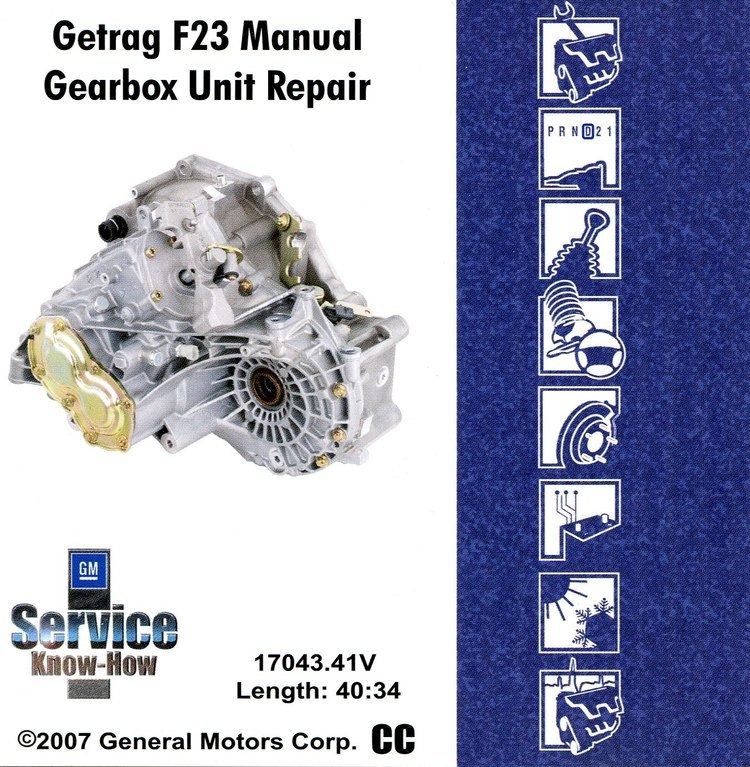 | ||
The F23 is a five-speed manual transmission manufactured by Getrag in Italy. It is designed for transverse engine applications, primarily by General Motors. It can handle torque inputs of over 230 newton metres (170 lbf·ft).
Contents
The Getrag F23 is a three-axis conventional transverse 5-speed manual transaxle with fully synchronized reverse gear. It features compact packaging, broad low-torque applications, and reliable operation.
The F23 has two gearsets on each of three parallel shafts – the input shaft, the output shaft, and the intermediate shaft. This three-shaft (also called three-axis) design results in a very short axial length for better packaging. There are three separate shift fork shafts, which hold three shift forks to activate the synchronizer rings for the two gearsets on each of the three gear shafts. The shift forks are activated by a cable system. The clutch release bearing is operated by a concentric slave cylinder that surrounds the input shaft in the clutch housing. A concentric slave cylinder allows more linear clutch feel than an external lever-actuated clutch and release bearing. The input shaft carries the 3rd and 4th gear synchronizer, the intermediate shaft carries the 1st and 2nd gear synchronizer, and the output shaft carries the 5th and reverse gear synchronizer. The aluminium case contains a conventional final drive gearset.
There are sintered bronze double-cone blocker rings on the synchronizers for 1st and 2nd gears, while 3rd and 4th gears use carbon fiber blocker rings, and 5th and Reverse gears use molybdenum on their synchronizers. Carbon and molybdenum are extremely durable friction surfaces that remain stable even under extreme heat.
In the U.S. market, General Motors uses the F23 in two versions (with several application variations): the M86/M94 and MG3.
There is now an aftermarket source for limited slip differentials, of the helical-gear, torque-sensing / torque-biasing design.
M86/M94
Regular Production Option (RPO) code M86 and M94 is rated for lighter vehicles with a maximum gross vehicle weight rating (GVWR) of 1,857 kilograms (4,094 lb).
MG3
RPO code MG3 is rated for heavier vehicles with a maximum GVWR of 2,030 kilograms (4,475 lb).
Rattling / Grinding
On January 28, 2002, General Motors released a Technical Service Bulletin (TSB #02-07-29-001) addressing a "Grinding/Rattle Type Noise Coming From Transmission". The TSB was intended for the following GM vehicles equipped with the GM Quad 4 (RPO LD9) Engine and Getrag M86/M94 5-Speed Transmissions:
The bulletin continued to explain that there are actually two distinguishable noises which have two very different remedies.
Making a sharp right hand turn will usually stop the noise. While the noise is occurring, in order to distinguish between the two noises, you can press lightly on the clutch pedal without releasing the clutch and the noise will NOT go away or change. As a second diagnostic aid, while the vehicle is making the noise, shift to third gear and the noise will stop.
General Motors provided a fix for "Noise #1" but stated that "Noise #2" was a characteristic of any car equipped with a manual transmission and that a similar noise could be repeated by lugging the engine. The remedy for "Noise #1" was to overfill the transmission with Saturn Manual Transmission Lubricant from the stock 1.8 quarts to 2.6 quarts. Although this seemed to work for many customers, many other complaints still surfaced and in 2003 General Motors released another TSB urging customers that still have the rattling noise in their transmissions should bring their vehicles in to their nearest General Motors affiliated dealer for a more complex fix. This time, GM Technicians had concluded that gears one and two required additional thrust loads and proceeded to install a wave washer between the blocking ring and speed gears for gears three and four. This indeed fixed the rattle issue once and for all, but has more recently been lamented in many online communities as causing a bigger problem than it solves, as many customers that received this fix reported third and fourth gears grinding from time to time while shifting. Afterwards, many owners of these vehicles have concluded that leaving the transmission alone was for the best, as the rattling noise has been proven to be harmless.
